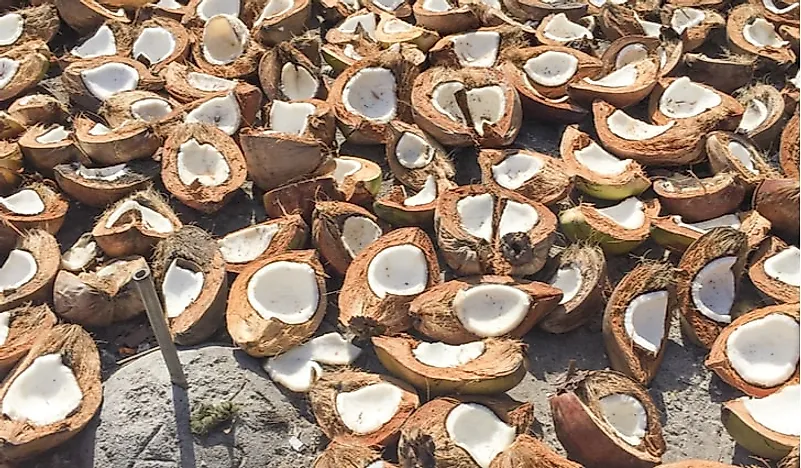What Is Copra And How Is It Made?

Copra is the processed, dried kernel of coconut utilized in the extraction of coconut oil. Copra is utilized for a variety of purposes. It is used as food as it an important source of nutrients including proteins, vitamins, and minerals. Hot pressing the copra yields a low-melting oil that has a melting point of 23 degrees Celsius. This oil can be used in cooking and as a raw material for preparing hair oils, shampoos, detergents, margarine, and more. The residual material, known as coconut cake, is a valuable concentrated feed for livestock. One coconut palm nut can yield around 80-500 g of copra.
Growing Regions
Copra comes from the coconut palm, which grows in tropical regions of the world. Indonesia, the Philippines, India and Brazil are among the world's top coconut producers. The coconut palm is a commercially beneficial plant as it is possible to use all sections of the plant for commercial purposes. Aside from the aforementioned countries, Vanuatu, Papua New Guinea and some other tropical Pacific islands also produce copra. Malaysia and Mozambique also grow coconut palms yielding copra. Brazil, India, and Sri Lanka are also major copra producers. The coconut palm is more often grown by smallholders in their private fields although large plantations of coconut palms also exist.
How is Copra Made?
To make copra, coconut nuts are broken open, water is drained out, and the kernel is left to dry. Sun drying and kiln drying are just some of the methods employed to dry the kernels. The kernels are then crushed to extract oil which is then utilized for various purposes while the byproduct is harnessed in supplying fodder for livestock.
If copra is not dried safely, it is possible for a harmful mould called Aspergillus flavus to form. The mould can be avoided if farmers only harvest mature nuts and by protecting their coconut yield from rain and moisture. If drying naturally, copra should be left out in the sun for at least four days (ideally five).
What is Copra Used For?
The following are just some of the common uses of copra:
- Coconut oil is commonly used in baking and cooking
- Coconut oil is a favorite ingredient in beauty products for its moisture and texture
- The coconut cake produced by making copra is commonly used as livestock food
- Coconut scent is widely used in products such as candles and soaps
- Coconut oil is an edible fat comparable to butter or margarine
Across Asia, especially in India, a whole coconut, sometimes copra slices, are also used for religious purposes. All religious ceremonies in Hinduism begin with the proposal of whole coconut, copra or the coconut water to the deity Ganesha, who helps in the successful completion of any work. Any serious business should begin with the ceremony of breaking a coconut. Coconut’s firm copra and its thick outer layer are symbols of hard work and the concomitant success. The sacrificial meanings of coconut copra in ancient history ascend to the Hindu Sage Vishvamitra, who first introduced the nut to the pre-historic people as a means to improve eyesight and general health.
Global Market
Copra, more specifically the coconut oil extracted from copra, has a global market. In 2002, 1822 million metric tons of coconut oil were exported from copra producing nations of the world. The small Pacific Islands often suffer dominance by the large-scale producers of copra like Philippines, Indonesia, and others. The European Union helps these isolated island countries by implementing a preferential tariff system, which boosts exports from these countries. Coconut oil exports are also facing intense competition from other, cheaper plant oil sources like the palm oil. Coconut farmers across the world are thus seeking for intervention on the part of their governments to receive subsidies in the price coconut oil to offer the product at more lucrative prices in the world market. There is also a need of technological improvements in the copra plantations to improve copra yields.
The world's largest importers of coconut oil include the European Union, the United States, Malaysia, China, and Korea. In 2018, the European Union alone imported 475,000 metric tons of coconut oil. The popularity of this flexible substance does not seem to show any signs of slowing down anytime soon.











